
1radiation_people_and_the_environment
.pdf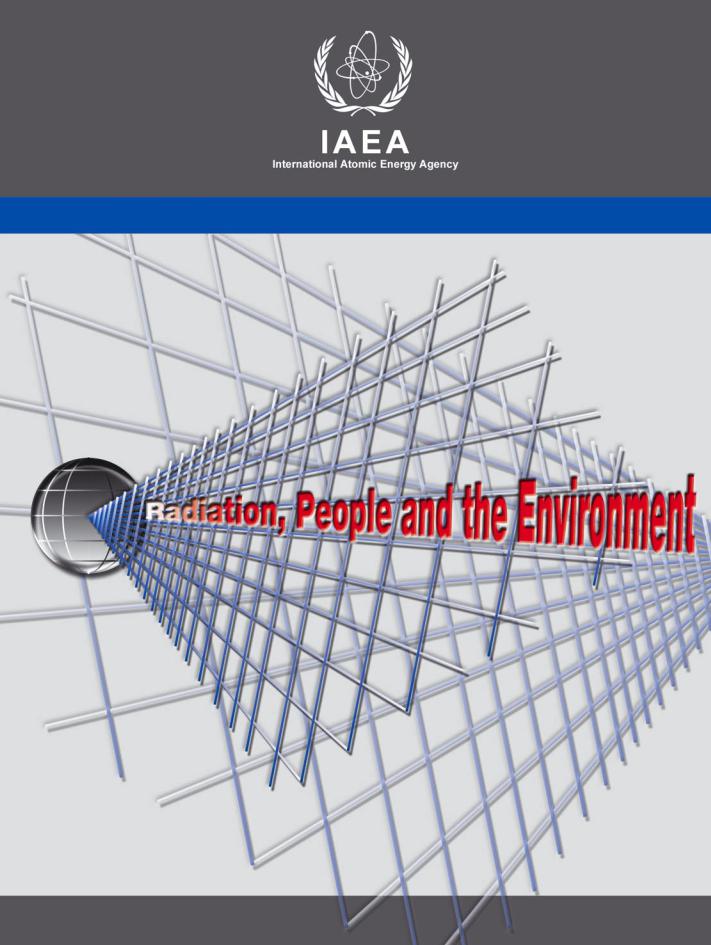
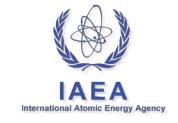
RADIATION, PEOPLE AND THE ENVIRONMENT
... a broad overview of ionizing radiation, its effects and uses,
as well as the measures in place to use it safely

Contents
CONTENTS
Chapter 1 Introduction 1
Benefits and risks 2 / Public anxiety 2
Chapter 2 Atoms and radiation 3
Structure of matter 3 / Radioactivity and radiation 4 / Types of radiation 7
Chapter 3 Radiation and matter 9
Ionization in tissue 10 / Dose quantities 11
Chapter 4 Sources of ionizing radiation 13
Chapter 5 Radiation effects 15
Induction of cancers 16 / Risk assessments 16 / Risk factors for cancers 17 Hereditary disease 19 / Communal risk 21 / Irradiation in pregnancy 21
Chapter 6 System of radiological protection 23
General principles 23 / Scope of application 25 / Justification of practices 25 Optimization of protection 26 / Limitation of doses 27
The International Basic Safety Standards 28 / Regulatory infrastructure 28
Chapter 7 Natural radiation 29
Cosmic radiation 29 / Gamma radiation 30 / Radon inhalation 31 Internal irradiation 32 / Total doses 32
Chapter 8 Medical uses of radiation 33
Diagnostic radiology 34 / Nuclear medicine 35 Radiotherapy 36 / Guidance levels for medical exposure 37 Total doses 38

Contents
Chapter 9 Occupational exposure to radiation 39
Artificial sources 40 / Natural sources 41 / Total doses 42
Chapter 10 Environmental pollution 43
Nuclear weapon tests 43 / Chernobyl accident 45 / Radioactive discharges 47 Depleted uranium 49 / Managing contaminated areas 49 / Total doses 50
Chapter 11 Nuclear power 51
Nuclear reactors 51
Chapter 12 Waste management 53
Decommissioning 55 / Disposal criteria 56 / Other waste management practices 57
Chapter 13 Emergencies 59
Nuclear emergencies 60 / Countermeasures 61
Intervention standards 62 / Public information 63
Other radiological emergencies 63
Chapter 14 Risks from radiation sources 65
Accidents involving radiation sources 65
Lost sources causing contamination incidents 67 / Radioactive Dispersal Devices 68
Chapter 15 Transport of radioactive materials 69
Appendix A
Glossary 71
Appendix B
Symbols and Units 79 / Scientific notation 79
Prefixes 79 / Symbols 80 / Units 80
Selected References 81
IAEA Publications 81 / ICRP Publications 81 / UNSCEAR Publications 81
OECD/NEA 81 / European Commission 81

Chapter 1 / Introduction
Chapter 1 Introduction
Radiation is a fact of life. We live in a world in which radiation is naturally present everywhere. Light and heat from nuclear reactions in the Sun are essential to our existence. Radioactive materials occur naturally throughout the environment, and our bodies contain radioactive materials such as carbon-14, potassium-40 and polonium-210 quite naturally. All life on Earth has evolved in the presence of this radiation.
Since the discovery of X rays and radioactivity more than 100 years ago, we have found ways of producing radiation and radioactive materials artificially. The first use of X rays was in medical diagnosis, within six months of their discovery in 1895. So a benefit from the use of radiation was established very early on, but equally some of the potential dangers of radiation became apparent in the doctors and surgeons who unwittingly overexposed themselves to X rays in the early 1900s. Since then, many different applications of radiation and radioactive materials have been developed.
We can classify radiation according to the effects it produces on matter, into ionizing and non-ionizing radiation. Ionizing radiation includes cosmic rays, X rays and the radiation from radioactive materials. Non-ionizing radiation includes ultraviolet light, radiant heat, radio waves and microwaves.
This book deals with ionizing radiation, a term, which for simplicity, is often shortened to just radiation. It has been prepared by the International Atomic Energy Agency (IAEA) in co-operation with the National Radiological Protection Board (United Kingdom) as a broad overview of the subject of ionizing radiation, its effects and uses, as well as the measures in place to use it safely.
As the United Nations agency for nuclear science and its peaceful applications, the IAEA offers a broad spectrum of expertise and programmes to foster the safe use of radiation internationally. It has a statutory responsibility for the development of safety standards that are applicable to managing the wide variety of applications that use radiation. It provides assistance to its Member States on the application of those standards through technical co-operation projects such as training courses and advisory services. It also facilitates information exchange through conferences, and publications, such as this one.
RADIATION, PEOPLE AND THE ENVIRONMENT 1
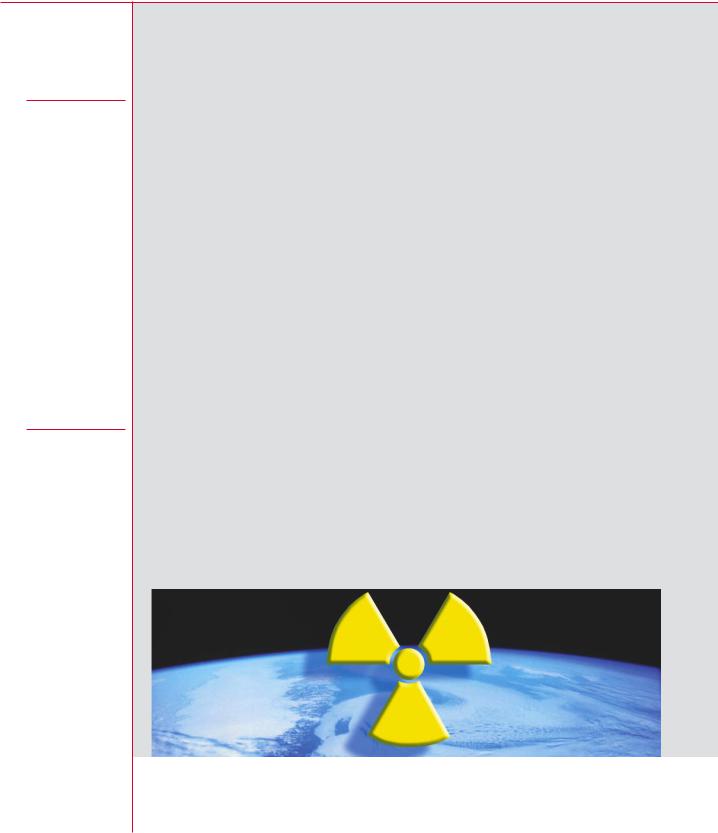
Chapter 1 / Introduction
Benefits and risks
The benefits and risks of any practice involving radiation need to be established, so that an informed judgement can be made on their use, and any risks minimized. The discovery of ionizing radiation and radioactive materials has led to dramatic advances in medical diagnosis and treatment, and they are used for a wide range of procedures
Some uses of in industry, agriculture, and research. Nevertheless, they can be harmful to human ionizing radiation beings, and people must be protected from unnecessary or excessive exposures. So in circumstances that we can control, we need to make a careful balance between the
Medical diagnosis benefits and the risks of the procedures that expose people to radiation. and treatment
Nuclear power Public anxiety
Industrial The greatest concern about ionizing radiation stems from its potential to cause malig- radiography nant diseases in people exposed to it and inherited defects in later generations. The likelihood of such effects depends on the amount of radiation that a person receives, Sterilization of whether from a natural or an artificial source. As the effects of ionizing radiation have
medical equipment become better understood during recent decades, a system of radiological protection has been developed to protect people from exposure to sources of radiation. But
Food irradiation public anxiety remains.
Satellite batteries Radiation is one cause, among many, of the ‘dread disease’ cancer. Our senses cannot detect radiation, making this invisible risk seem even more insidious. Our collective Scientific and anxiety is strengthened by memories — and, in some cases, ongoing effects — of
medical research accidents at nuclear power plants and other facilities, and by the common tendency to associate any form of radiation with all things ‘nuclear’, including nuclear weapons.
Another contributory reason for general heightened sense of concern about radiation may be the lack of reliable and accessible information and the misunderstandings that arise. The aim of this book is to help by providing information for those who are not experts. In the following chapters, we describe the sources and effects of ionizing radiation of all types and explain the principles and practices of radiological protection.
2RADIATION, PEOPLE AND THE ENVIRONMENT

Chapter 2 / Atoms and radiation
Chapter 2 Atoms and radiation |
|
Structure of matter |
|
All matter in the world about us consists of atoms. These are the basic building blocks |
The oxygen |
of the elements such as hydrogen, carbon, oxygen, iron, and lead. Each atom contains |
atom planetary |
a tiny central positively charged nucleus and a number of electrons. The electrons |
presentation with |
carry negative electric charge and move around the nucleus in clouds — or shells as |
a nucleus of |
they are called — with loosely defined boundaries. The nucleus is typically 10 000 times |
8 protons and |
smaller than the electron clouds and the electrons themselves are even smaller. This |
8 neutrons within |
means that the atom is mainly empty and difficult to depict except in diagrams, which |
8 orbital electrons |
are largely schematic. |
|
The nucleus of the atom contains protons, which carry a positive charge equal to the |
|
electron’s negative charge, and neutrons, which carry no charge at all. It is not |
|
necessary here to consider the more fundamental structure of |
|
protons and neutrons, or how in detail they are bound |
|
together in the nucleus. Each atom contains equal |
|
numbers of protons and electrons and is therefore |
|
electrically neutral. Atoms of the same or different |
|
elements can, combine to form larger, uncharged |
|
entities called molecules. For example, two atoms |
|
of oxygen form one molecule of oxygen, and two |
|
atoms of hydrogen combine with one atom of |
|
oxygen to form one molecule of water. |
|
The number of electrons in the atom — and hence the number of protons in the |
|
nucleus, called the atomic number — gives an element its unique characteristics. The |
|
atomic number of carbon is 6, for instance, whereas for lead it is 82. Because protons |
|
and neutrons have the same mass, and are much heavier than electrons, most of an |
|
atom’s mass is concentrated in the nucleus, and the total number of protons plus |
|
neutrons is called the mass number. |
Nucleus = |
|
Protons + neutrons |
Since the number of electrons equals the number of protons in an electrically neutral |
|
atom, we can specify an atomic species by the number of protons and neutrons it contains. |
|
Moreover, since the number of protons is unique to each element, we can simply use |
|
RADIATION, PEOPLE AND THE ENVIRONMENT |
3 |
|
|
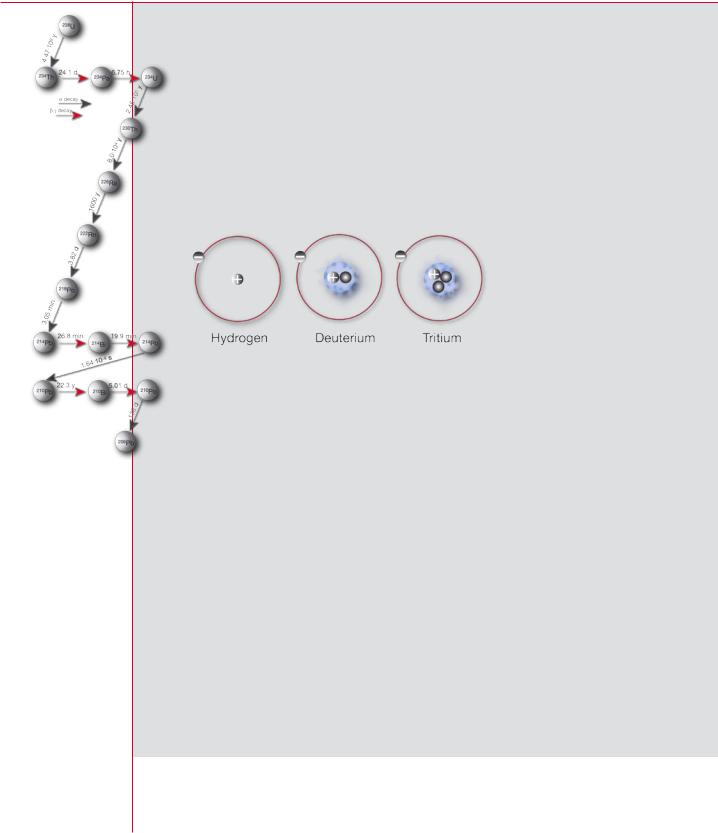
Chapter 2 / Atoms and radiation
the name of the element together with the mass number to specify each species or nuclide. So carbon-12 is a nuclide with six protons plus six neutrons. Lead-208, for comparison, is a nuclide with 82 protons and 126 neutrons.
Nuclides of an element that have the same number of protons, but different numbers of neutrons, are called isotopes of that element. Hydrogen, for instance, has three isotopes: hydrogen-1 (common hydrogen with a nucleus of only one proton), hydrogen-2 called deuterium (one proton and one neutron), and hydro- gen-3 called tritium (one proton and two neutrons). Iron has ten isotopes from iron-52 to iron-61, all with the 26 protons that characterize the element, but with 26 to 35 neutrons.
Isotopes of hydrogen
Nucleus =
Protons + neutrons
Radioactivity and radiation
Although many nuclides are stable, most are not. Stability is determined mainly by the balance between the number of neutrons and protons a nuclide contains. Smaller stable nuclei have about equal numbers: larger stable nuclei have slightly more neutrons than protons. Nuclei with too many neutrons tend to transform themselves to a more stable structure by converting a neutron to a proton: this process,
Decay of known as beta decay, results in the emission of a negatively charged electron called radionuclides: a beta particle. Nuclei with too many protons convert the excess protons to neutrons different types of in a different form of beta decay: they lose positive charge through the emission of a
radiation and positron, which is a positively charged electron. half-lives for
uranium-238 These transformations often leave the nucleus with excess energy that it loses as series gamma rays — high energy photons, which are discrete parcels of energy without mass or charge. The spontaneous transformation of a nucleus is called radioactivity, and the excess energy emitted is a form of (ionizing) radiation. The act of transformation is termed decay and the nuclide that changes and emits radiation is called
a radionuclide.
Some heavy nuclei decay by producing an alpha particle consisting of two protons and two neutrons. Identical with a nucleus of helium, the alpha particle is much heavier than the beta particle and carries two units of positive charge.
4RADIATION, PEOPLE AND THE ENVIRONMENT

|
|
|
Chapter 2 / Atoms and radiation |
|
|
|
|
|
|
|
|
|
|
|
|
|
Molecule = |
Natural Radionuclides |
|
|
|
Combined atoms |
|
|
carbon-bearing materials is the basis of |
|
|||
|
|
|
the technique of carbon dating. |
|
|
Many radionuclides occur in nature. Carbon, |
|
|
|
||
for instance, is mostly in the form of car- |
Othernaturallyoccurringradionuclidesare |
|
|||
bon-12 with six protons and six neutrons |
formed in sequences or series of decays |
|
|||
and is completely stable. Interactions |
that originate from the elements uranium |
|
|||
with cosmic rays in the atmosphere |
and thorium. Each of these series ends |
|
|||
can produce carbon-14, a radionuclide |
with a stable nuclide of lead, but they |
|
|||
consisting of six protons and eight neu- |
also pass through radionuclides of other |
Water molecule |
|||
trons. Carbon-14, with its extra neutrons, |
familiar elements. The diagram shows the |
|
|||
decays by changing a neutron to a proton |
decay series from uranium-238 ending in |
|
|||
and emitting a beta particle: in this way, |
the stable nuclide lead-206: it passes |
|
|||
the nuclide transforms to stable nitrogen-14, |
through the radionuclide radon-222, which |
Atom = |
|||
which consists of seven protons and seven |
is of special significance in radiological |
Nucleus + electrons |
|||
neutrons. Measuring these decays in |
protection. |
|
|||
|
|
|
|
|
|
|
Radionuclides |
Unstable nuclides |
|
||
|
Radioactivity |
Emission of radiation |
|
||
|
Radiation types |
Alpha, beta, gamma, |
|
||
|
neutron, and X ray |
|
|||
|
Activity |
Decay rate of radionuclide |
|
||
|
Half-life |
Time to half activity |
Nuclide = |
||
|
|
|
|
|
Species of atom |
Radiation Energy |
|
|
|
||
|
|
|
|
||
The energy of the various types of radiation — alpha and beta particles and gamma rays
— is usually expressed in the unit of electron volt, symbol eV. Multiples of this unit are oftenused,suchasamillionor106 electronvolts,symbolMeV.Forinstance,theenergyof alpha particles emitted by polonium-214 is about 7.7 MeV. Beta particles from lead-214, also formed in the uranium-238 decay series, have a maximum energy of 1.0 MeV, and gamma rays produced by it have energies up to 0.35 MeV.
During the past few decades, several hundred radioactive isotopes (radioisotopes) of natural elements have been produced artificially including, for example, strontium-90, caesium-137 and iodine-131. Several new radioactive elements have also been produced in quantity, for instance promethium and plutonium, although the latter does occur naturally in trace amounts in uranium ores.
RADIATION, PEOPLE AND THE ENVIRONMENT 5
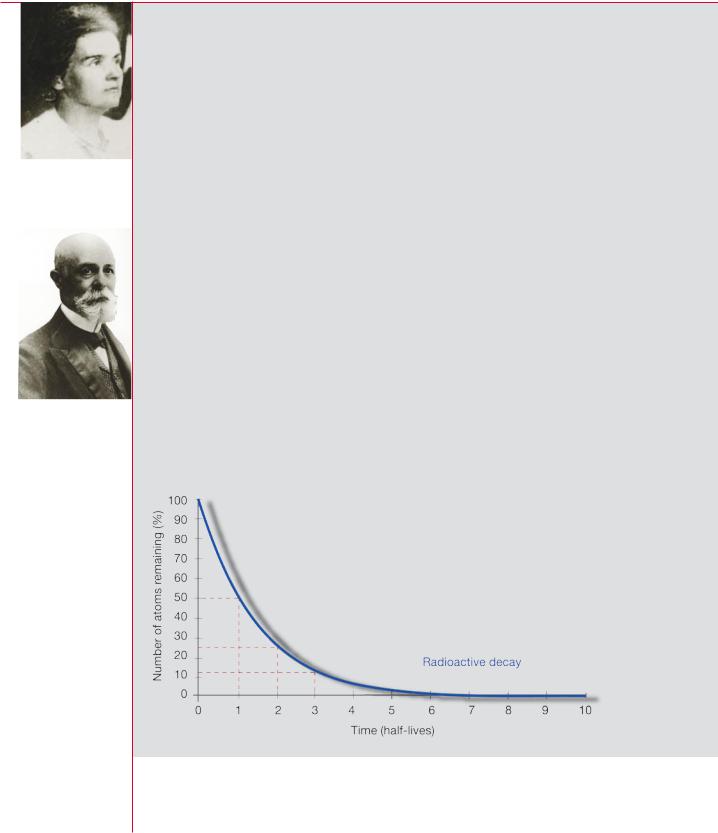
Chapter 2 / Atoms and radiation
The rate at which spontaneous transformations occur in a given amount of a radioactive material is known as its activity. Activity is expressed in a unit called the becquerel, symbol Bq, where 1 Bq equals one transformation per second. The becquerel is named after the French physicist Henri Becquerel. As the unit is so small, multiples of the becquerel are frequently used, such as the megabecquerel, MBq, which is 1 million becquerels. One gram of radium-226, for instance, has an activity of approximately 37 000 MBq: it emits about 37 000 million alpha particles each second (an old unit of activity, the curie — named after the Polish-born French scientist Marie Curie — was originally defined as the activity of one gram of radium).
Marie Curie (1867–1934)
Half lives |
30 years; |
carbon-14, |
5730 |
years; |
|
|
plutonium-239, 24 000 years; and |
||||
The time taken for the activity of a |
uranium-238, 4470 million years. In |
||||
radionuclide to fall to half its original |
successive |
half-lives, |
the |
activity |
|
value is called the half-life, symbol t1⁄2. |
of a radionuclide is reduced by |
||||
Put another way, this is the time for |
decay to |
1⁄2, |
1⁄4, 1/8 and so |
on, of |
|
half the nuclei in a sample to decay. |
its initial value. This means that we |
||||
Each radionuclide has a unique half- |
can predict the activity remaining at |
||||
life, which can range from fractions |
any future time. As the amount of a |
||||
of a second to billions of years. For |
radionuclide |
decreases, |
the radiation |
||
iodine-131, it is 8 days; caesium-137, |
emitted |
decreases proportionately. |
|||
Henri Becquerel
(1852–1908)
6RADIATION, PEOPLE AND THE ENVIRONMENT
